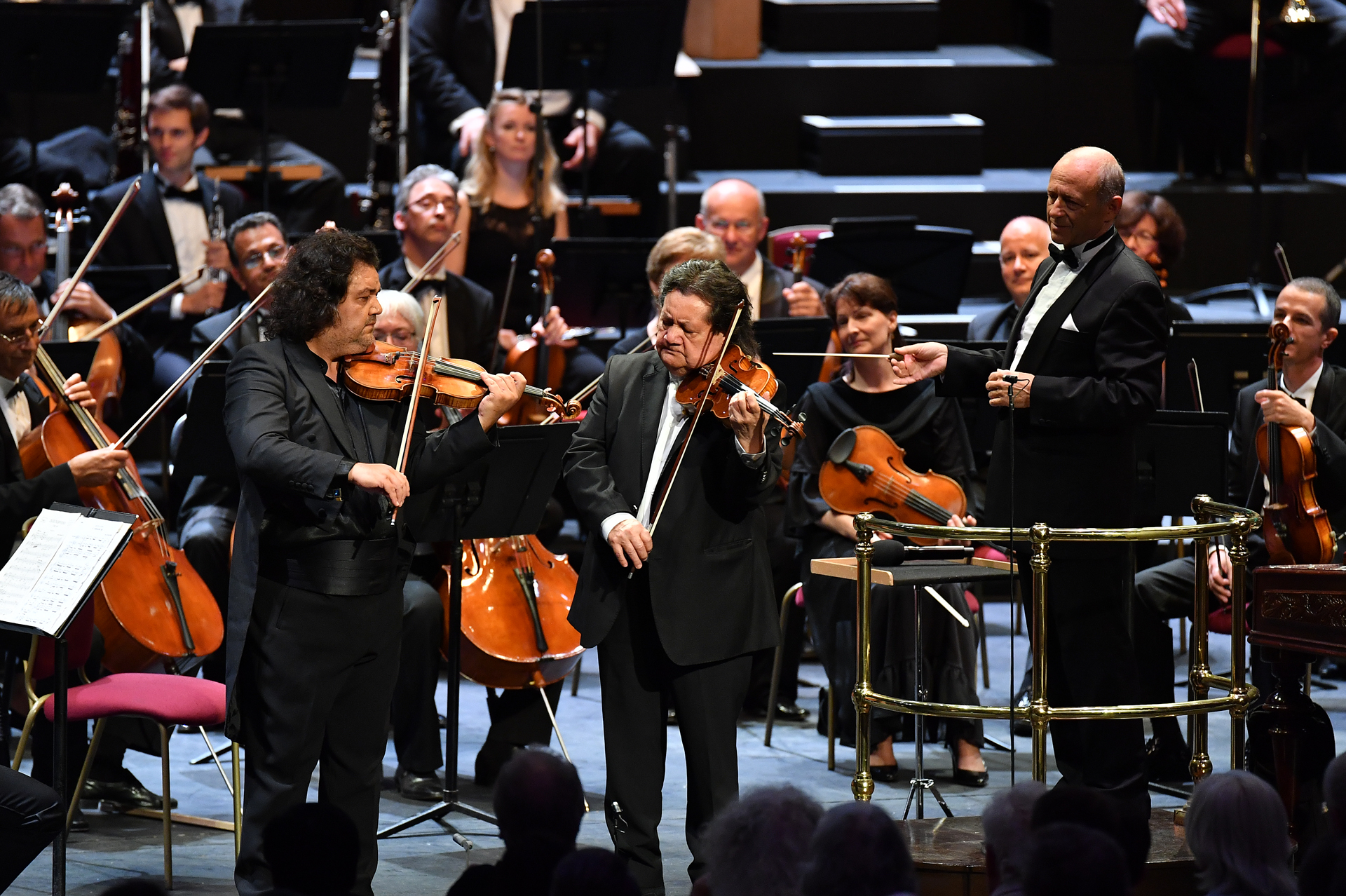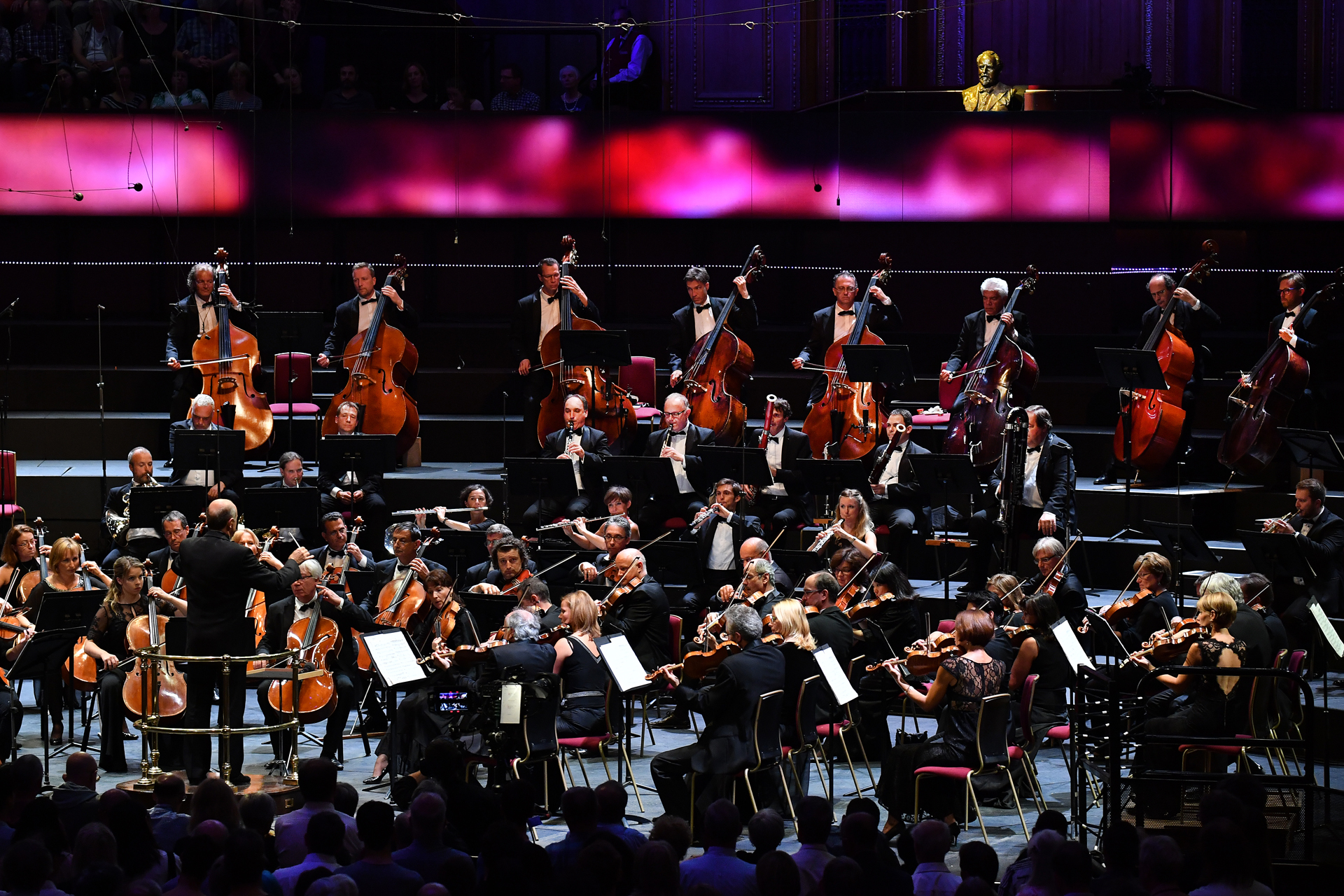Prom 55, Lisztes, Lendvai, Lendvay, Budapest Festival Orchestra, Fischer review - unity and strength | reviews, news & interviews
Prom 55, Lisztes, Lendvai, Lendvay, Budapest Festival Orchestra, Fischer review - unity and strength
Prom 55, Lisztes, Lendvai, Lendvay, Budapest Festival Orchestra, Fischer review - unity and strength
Gypsy fiddlers, fizzing cimbalom and celestial Brahms
There seems no limit to the sheer creativity that fizzes from Iván Fischer and his Budapest Festival Orchestra. For their second night at the Proms, packed out this time, the theme was the meeting of classical and Gypsy musical traditions.
Nothing asserts “Hungarian Gypsy music” quite strongly as a cimbalom centre stage. In case you haven’t met one before, it’s a large zither on legs, its elaborate system of strings played with a pair of beaters, uttering a sound with an acidic, metallic sparkle to it. A great performance on one can dazzle the bejesus out of you.
Jenö Lisztes, one of today’s most famous exponents, often to be found in Roby Lakatos’s ensemble, took centre stage for an eye and ear-popping improvisation before serving as soloist for Liszt’s Hungarian Rhapsody No.1, his extra cadenzas warming up the audience to a point at which the notion of hearing an actual Brahms symphony later on began to seem redundant. He then melded into the orchestra throughout the first half, the sound adding a soft fizz and glitter to the textural background, however Brahms and Liszt the proceedings. 
Lendvay junior is a chip off the old block, but also has to his name a cavalcade of great classical teachers, competition first prizes, Hungarian state honours and, not least, a Strad. His performance of Sarasate’s Zigeunerweisen mingled the two styles ideally, the sound focused and projected, the tone sweet and sure, the technical tricks of mingled left-hand pizzicato and bowed staccato tossed out so nonchalantly that it drew a laugh. Father and son rarely perform together, inhabiting different musical universes: but tonight a special arrangement of Brahms’s soulful Hungarian Dance No.11 united them at last.
You can just imagine the youthful Brahms and his star violinist friend Joseph Joachim soaking up Gypsy style in central European cafés. Brahms was so enchanted that he borrowed the tunes for his Hungarian Dances, little imagining that some themes were written by actual composers; he landed himself with a plagiarism charge. The dances were nevertheless one of his first big successes. The Symphony No.1, on the other hand, only reached the public many years later, the long shadow of Beethoven having proved understandably intimidating. Brahms made the first sketches in about 1855, but the premiere did not take place until 1876. It was, of course, declared Beethoven’s Tenth almost the minute it was heard. It may now be a Proms standard, but hearing it in this concert’s context added something unique to the experience. 
Fischer’s fluid tempi, his sense of overarching structure and emotional progression in combination with the transparency of textures, the flexible, plangent phrasing of the expert woodwind, and the unity of ensemble in this most homogenous of orchestras, made every note of this performance riveting. The symphony shone out in long-breathed, rich yet light-filled tone, a journey from the anguished opening to the great life-affirming finale by way of enormous, elemental energy.
These days no BFO concert is quite complete without a sung encore. This time it was the Brahms Hungarian Dance No.4, the orchestra singing the original Hungarian folksong, alternating with the instrumental version. A Hungarian song taken up by a Gypsy band and thence grabbed for classical transformation by Brahms: it’s not presented as a political point, and neither is the mix of the Jewish Hungarian conductor, Roma soloists and an almost-all-Hungarian orchestra, hugging each other. But in the context of present-day Hungary it makes one in any case – gloriously so. There’s more that unites us than divides us: music most of all.
- Listen to this Prom for the next month on the BBC iPlayer. Televised on BBC Four tonight
- Read more classical music reviews on theartsdesk
rating
Share this article
Add comment
The future of Arts Journalism
You can stop theartsdesk.com closing!
We urgently need financing to survive. Our fundraising drive has thus far raised £49,000 but we need to reach £100,000 or we will be forced to close. Please contribute here: https://gofund.me/c3f6033d
And if you can forward this information to anyone who might assist, we’d be grateful.

Subscribe to theartsdesk.com
Thank you for continuing to read our work on theartsdesk.com. For unlimited access to every article in its entirety, including our archive of more than 15,000 pieces, we're asking for £5 per month or £40 per year. We feel it's a very good deal, and hope you do too.
To take a subscription now simply click here.
And if you're looking for that extra gift for a friend or family member, why not treat them to a theartsdesk.com gift subscription?
more Classical music
 Echo Vocal Ensemble, Latto, Union Chapel review - eclectic choral programme garlanded with dance
Beautiful singing at the heart of an imaginative and stylistically varied concert
Echo Vocal Ensemble, Latto, Union Chapel review - eclectic choral programme garlanded with dance
Beautiful singing at the heart of an imaginative and stylistically varied concert
 Scott, Irish Baroque Orchestra, Whelan, RIAM, Dublin review - towards a Mozart masterpiece
Characteristic joy and enlightenment from this team, but a valveless horn brings problems
Scott, Irish Baroque Orchestra, Whelan, RIAM, Dublin review - towards a Mozart masterpiece
Characteristic joy and enlightenment from this team, but a valveless horn brings problems
 Classical CDs: Voice flutes, flugelhorns and froth
Baroque sonatas, English orchestral music and an emotionally-charged vocal recital
Classical CDs: Voice flutes, flugelhorns and froth
Baroque sonatas, English orchestral music and an emotionally-charged vocal recital
 Kanneh-Mason, Britten Sinfonia, Shave, Milton Court - a grin and a big beaming smile
A pair of striking contemporary pieces alongside two old favourites
Kanneh-Mason, Britten Sinfonia, Shave, Milton Court - a grin and a big beaming smile
A pair of striking contemporary pieces alongside two old favourites
 theartsdesk at the New Ross Piano Festival - Finghin Collins’ musical rainbow
From revelatory Bach played with astounding maturity by a 22 year old to four-hand jazz
theartsdesk at the New Ross Piano Festival - Finghin Collins’ musical rainbow
From revelatory Bach played with astounding maturity by a 22 year old to four-hand jazz
 First Person: Manchester Camerata's Head of Artistic Planning Clara Marshall Cawley on questioning the status quo
Five days of free events with all sorts of audiences around Manchester starts tomorrow
First Person: Manchester Camerata's Head of Artistic Planning Clara Marshall Cawley on questioning the status quo
Five days of free events with all sorts of audiences around Manchester starts tomorrow
 Goldscheider, Brother Tree Sound, Kings Place review - music of hope from a young composer
Unusual combination of horn, strings and electronics makes for some intriguing listening
Goldscheider, Brother Tree Sound, Kings Place review - music of hope from a young composer
Unusual combination of horn, strings and electronics makes for some intriguing listening
 theartsdesk Q&A: composer Donghoon Shin on his new concerto for pianist Seong-Jin Cho
Classical music makes its debut at London's K-Music Festival
theartsdesk Q&A: composer Donghoon Shin on his new concerto for pianist Seong-Jin Cho
Classical music makes its debut at London's K-Music Festival
 Helleur-Simcock, Hallé, Wong, Bridgewater Hall, Manchester review - moving lyricism in Elgar’s concerto
Season opener brings lyrical beauty, crisp confidence and a proper Romantic wallow
Helleur-Simcock, Hallé, Wong, Bridgewater Hall, Manchester review - moving lyricism in Elgar’s concerto
Season opener brings lyrical beauty, crisp confidence and a proper Romantic wallow
 Kohout, Spence, Braun, Manchester Camerata, Huth, RNCM, Manchester review - joy, insight, imagination and unanimity
Celebration of the past with stars of the future at the Royal Northern College
Kohout, Spence, Braun, Manchester Camerata, Huth, RNCM, Manchester review - joy, insight, imagination and unanimity
Celebration of the past with stars of the future at the Royal Northern College

Comments
The most entertaining Prom so
Wholeheartedly agree with
Where can I buy this on cd?
Is it possible to buy a DVD